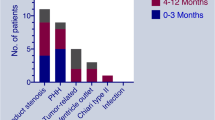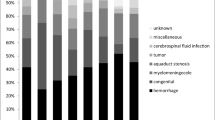Abstract
Background
Congenital hydrocephalus in infants treated with ETV has variable results in literature. We studied some supposed clinicoradiological parameters which though are considered vital in deciding operative management and have never been thoroughly studied to establish a well-defined association.
Aim and objective
To evaluate the influence of clinicoradiological profile and intraoperative findings over the outcome of ETV done in infants for congenital hydrocephalus.
Materials and methods
All infants who underwent ETV in King George’s Medical University, Lucknow, from January 2019 to February 2020 for congenital hydrocephalus were included. Their clinical, radiological, operative data was gathered. Infants were followed at 1, 3, and 6 months after ETV. ETV success was defined as stabilization of abnormal head growth with resolution of symptoms of raised ICP and no requirement of shunt surgery 6 months post-ETV. All the clinicoradiological and intraoperative factors were statistically correlated with the final outcome.
Results
Forty infants were operated for congenital hydrocephalus during the study period in our institution. Failure rate was higher in children younger than 3 months (p value of 0.04). Increase in head size was present in all 40 cases and bulging anterior fontanelle in 95% cases. Success rate of ETV at 1, 3, and 6 months was 62.5%, 40%, and 35%. Most of failure occurred within 3 months after the procedure. Expiry rate at 1, 3, and 6 month was 15%, 17.5%, and 17.5%. None of the intraoperative findings significantly correlated with the final outcome.
Conclusion
ETV can be a luring treatment of congenital hydrocephalus in infants but has limited success rate because of the dependency of procedure on well-formed arachnoid villi for absorption. It also carries minimal risk of fatal complications like CSF leak and meningitis associated with it. Age is the only factor which truly reflects the outcome of the procedure.





Similar content being viewed by others
Availability of data and materials
All the data is available in the medical record section of the institute (King George’s Medical University, Lucknow).
Abbreviations
- CSF:
-
Cerebrospinal fluid
- DWM:
-
Dandy-Walker malformation
- DLC:
-
Differential leukocyte count
- ETV:
-
Endoscopic third ventriculostomy
References
Balthasar AJR, Kort H, Cornips EMJ, Beuls EA, Weber JW, Vles JSH et al (2007) Analysis of the success and failure of endoscopic third ventriculostomy in infants less than 1 year of age. Childs Nerv Syst 23:151–155. https://doi.org/10.1007/s00381-006-0219-z
Damaty AE, Marx S, Cohrs G et al (2020) ETV in infancy and childhood below 2 years of age for treatment of hydrocephalus. Childs Nerv Syst 36(11):2725–2731. https://doi.org/10.1007/s00381-020-04585-8
Kulkarni AV, Riva-Cambrin J, Browd SR, Holubkov R, Drake JM, Kestle JRW et al (2016) Endoscopic third ventriculostomy in children: prospective, multicenter results from the Hydrocephalus Clinical Research Network. J Neurosurg Pediatr 18(4):423–429. https://doi.org/10.3171/2016.4.PEDS163
Lam S, Harris DA, Lin Y, Rocque BG, Ham S, Pan IW et al (2016) Outcomes of endoscopic third ventriculostomy in adults. J Clin Neurosci 31:166–171. https://doi.org/10.1016/j.jocn.2016.03.004
Limbrick DD Jr, Baksh B, Morgan G, Habiyaremye JP, McAllister et al (2017) Cerebrospinal fluid biomarkers of infantile congenital hydrocephalus. PLoS ONE 12(2). https://doi.org/10.1371/journal.pone.0172353
Zaben M, Manivannan S, Sharouf F, Hammad A, Patel C, Bhatti I et al (2020) The efficacy of endoscopic third ventriculostomy in children 1 year of age or younger: a systematic review and meta-analysis. Eur J Paediatr Neurol 26:7–14. https://doi.org/10.1016/j.ejpn.2020.02.011
Author information
Authors and Affiliations
Contributions
I declare the author has structured, refined and reviewed the above manuscript.
Corresponding author
Ethics declarations
Ethical approval
The study was approved by ethics committee of institute met on 12 July 2019 with reference code 97th ECM II B-Thesis/P49.
Consent to participate
A written informed consent was taken from each patient parents/legal guardian before including in study population. Those not giving consent were excluded.
Conflict of interest
The authors declare no competing interests.
Additional information
Publisher's Note
Springer Nature remains neutral with regard to jurisdictional claims in published maps and institutional affiliations.
Rights and permissions
Springer Nature or its licensor (e.g. a society or other partner) holds exclusive rights to this article under a publishing agreement with the author(s) or other rightsholder(s); author self-archiving of the accepted manuscript version of this article is solely governed by the terms of such publishing agreement and applicable law.
About this article
Cite this article
Verma, R. “Various factors affecting the success of the ETV procedure in infants”—an insight via a prospective study. Childs Nerv Syst 40, 1515–1523 (2024). https://doi.org/10.1007/s00381-023-06268-6
Received:
Accepted:
Published:
Issue Date:
DOI: https://doi.org/10.1007/s00381-023-06268-6




